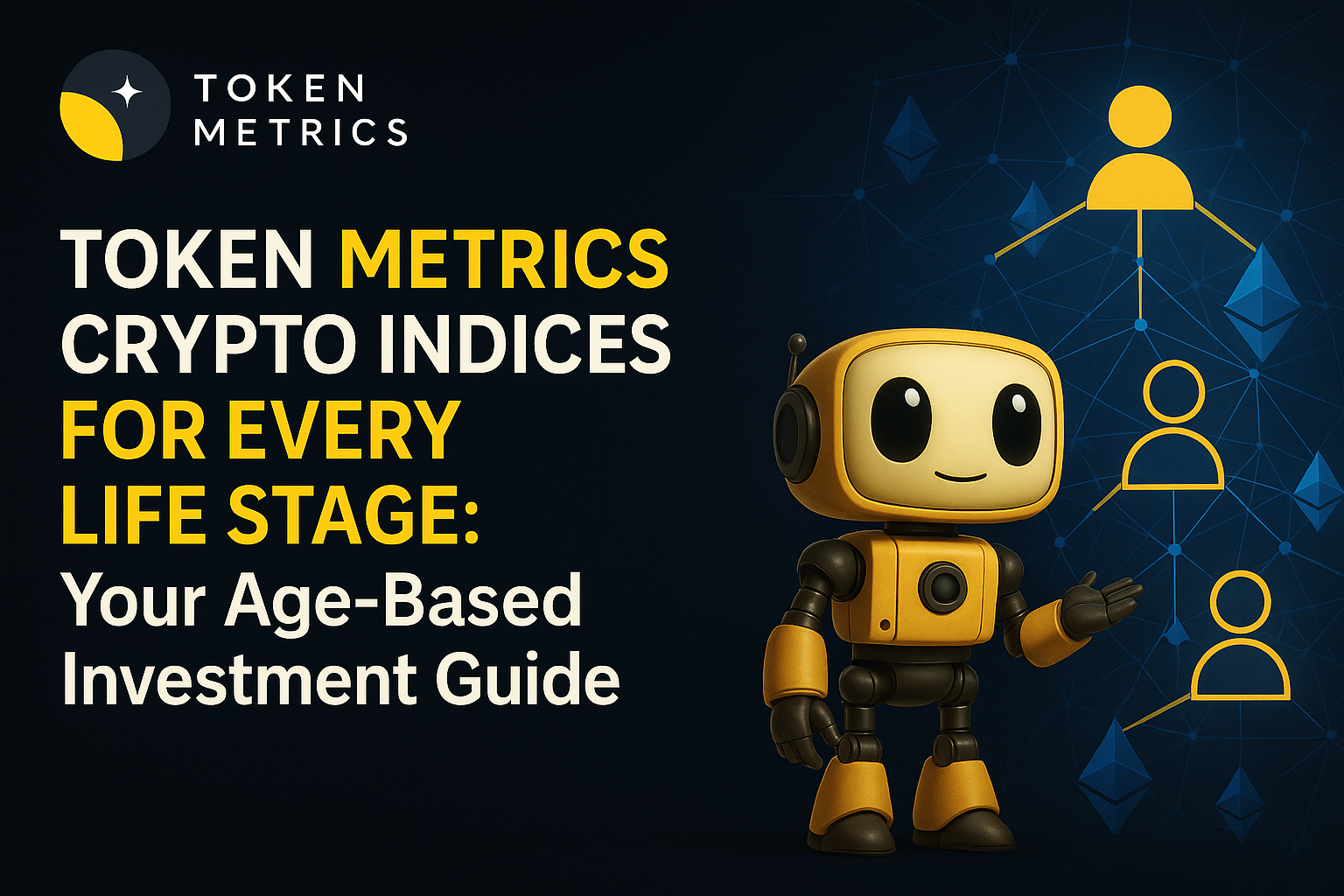
Top Bitcoin ETFs in 2024 - Token Metrics Moon Awards

Welcome to the Token Metrics Moon Awards, a highly esteemed accolade in the cryptocurrency industry that acknowledges the outstanding contributions of platforms and projects.
At Token Metrics, we take pride in our data-driven approach to investment research, and the Moon Awards are a testament to our commitment to recognizing the best crypto platforms, projects, and service providers of the year.
Honoring the Top Bitcoin ETFs of 2024
Today, we are thrilled to introduce a new category for the Moon Awards, where we will celebrate and honor the top Bitcoin ETFs of 2024. These ETFs have garnered significant support from crypto enthusiasts and investors in our survey, and we are excited to showcase their achievements.
Community-Driven Selection Process
At Token Metrics, we greatly value our audience and consider them our most valuable asset. Our community-driven approach ensures that the awards reflect the real-world opinions and experiences of crypto enthusiasts.
Through the Moon Awards, we aim to amplify the voice of our community and provide a transparent and user-centric evaluation of platforms that are driving the industry forward.
In collaboration with our community members and users' votes, we have curated a comprehensive list of the top Bitcoin ETFs in 2024 based on survey input and votes.
What is a Bitcoin ETF?
A Bitcoin ETF is a fund that tracks the price of Bitcoin and allows investors to buy shares of the fund on a stock exchange, just like they would with a regular stock.
The ETF holds Bitcoin as its underlying asset, and its value is directly tied to the price of Bitcoin. This means that as the price of Bitcoin goes up or down, the value of the ETF shares will also fluctuate.
Bitcoin ETFs come in different types, including spot Bitcoin ETFs, Bitcoin futures ETFs, and Bitcoin strategy ETFs. A spot Bitcoin ETF tracks the current price of Bitcoin, while a Bitcoin futures ETF invests in Bitcoin futures contracts.
A Bitcoin strategy ETF utilizes various investment strategies related to Bitcoin, such as investing in companies with significant Bitcoin holdings.
One of the main advantages of a Bitcoin ETF is that it allows investors to gain exposure to Bitcoin's price movements without the complexities of buying, storing, and safekeeping Bitcoin themselves. Additionally, Bitcoin ETFs are regulated financial products, providing investors with a level of protection and oversight.
How Do Bitcoin ETFs Work?
Bitcoin ETFs create shares representing ownership of the underlying Bitcoin held by the fund. These shares are traded on stock exchanges, allowing investors to buy and sell them throughout trading.
The price of the ETF shares is typically designed to track the price of Bitcoin closely. However, due to factors such as fees and market demand, there may be slight discrepancies between the ETF's price and the price of Bitcoin.
When investors buy shares of a Bitcoin ETF, they essentially buy a fraction of the underlying Bitcoin held by the fund. The ETF provider is responsible for managing the Bitcoin holdings and handling tasks such as custody and security.
This allows investors to gain exposure to Bitcoin without the need to own or manage the cryptocurrency themselves directly.
Top Bitcoin ETFs in 2024
Now, let's take a closer look at some of the top Bitcoin ETFs available in 2024:

BlackRock
In the Token Metrics Moon Awards survey, BlackRock secured the top position with 49.7% of the total votes.
BlackRock offers the iShares Bitcoin Trust (IBIT), which is one of the most well-known and popular Bitcoin ETFs in the market.
The IBIT aims to reflect the performance of the price of Bitcoin directly and has attracted significant investor interest. As of early 2024, the fund's assets under management (AUM) stood at approximately $2.2 billion.
Grayscale
In the Token Metrics Moon Awards survey, Grayscale secured the 2nd position with 30.6% of the total votes.
Grayscale Bitcoin Trust (GBTC) is one of the oldest and most established Bitcoin investment vehicles. While not an ETF in the traditional sense, GBTC has served as a popular way for investors to gain exposure to Bitcoin. It is structured as a trust and allows investors to hold Bitcoin in traditional investment accounts.
Fidelity
In the Token Metrics Moon Awards survey, Fidelity secured the 3rd position with 7% of the total votes.
Fidelity offers the Wise Origin Bitcoin Fund (FBTC), which provides investors with direct exposure to Bitcoin. The fund's performance tracks the price of Bitcoin as measured by the Fidelity Bitcoin Index. With Fidelity's reputation as one of the largest investment managers in the world, the FBTC has gained popularity among investors.
Ark/21Shares
In the Token Metrics Moon Awards survey, ARK 21Shares secured the 4th position with 3.7% of the total votes.
The ARK 21Shares Bitcoin ETF (ARKB) is a collaboration between ARK Invest and 21Shares. ARK Invest is known for its focus on disruptive innovation and has been a vocal proponent of the potential of cryptocurrencies. The partnership with 21Shares brings together expertise in innovation-focused investing and digital asset management.
Bitwise
In the Token Metrics Moon Awards survey, Bitwise secured the 5th position with 3.6% of the total votes.
Bitwise offers the Bitwise 10 Crypto Index Fund, which tracks the performance of the top 10 cryptocurrencies, including Bitcoin. The fund aims to provide diversified exposure to the cryptocurrency market and has gained popularity among investors looking for broad crypto exposure.
VanEck
In the Token Metrics Moon Awards survey, VanEck secured the 6th position with 3.2% of the total votes.
VanEck is a well-known asset management firm that offers the VanEck Bitcoin Trust. The trust provides investors with exposure to Bitcoin's price movements and is designed to track the performance of Bitcoin closely. VanEck has a long history in the ETF space, making its Bitcoin Trust a reputable option for investors.
Valkyrie
In the Token Metrics Moon Awards survey, Valkyrie secured the 7th position with 0.9% of the total votes.
Valkyrie offers the Valkyrie Bitcoin Trust, which aims to provide investors with exposure to Bitcoin's price movements. The trust is structured as a grantor trust and seeks to track the performance of Bitcoin. Valkyrie is known for its expertise in digital assets and has attracted attention from investors seeking Bitcoin exposure.
Advantages and Disadvantages of Bitcoin ETFs
Bitcoin ETFs offer several advantages for investors looking to gain exposure to Bitcoin:
- Convenience: Investing in a Bitcoin ETF is as easy as buying any other stock on a stock exchange. It eliminates the need to navigate cryptocurrency exchanges and deal with the complexities of owning and storing Bitcoin.
- Regulation: Bitcoin ETFs are regulated financial products, providing investors with oversight and protection. This can help instill confidence in investors who may be wary of the unregulated nature of the cryptocurrency market.
- Diversification: Bitcoin ETFs often hold a diversified portfolio of assets, including Bitcoin, Bitcoin futures contracts, and stocks of companies involved in blockchain technology. This diversification can help mitigate some risks associated with investing in individual cryptocurrencies.
However, some disadvantages are also to consider:
- Fees: Bitcoin ETFs charge fees to cover their operating expenses, which can eat into investors' returns. It's important to consider the fees associated with each Bitcoin ETF before investing.
- Tracking Error: Due to factors such as fees and market demand, there may be slight discrepancies between the price of a Bitcoin ETF and the price of Bitcoin it aims to track. This is known as a tracking error and can impact the overall performance of the ETF.
- Volatility: Bitcoin and the cryptocurrency market as a whole are known for their volatility. While Bitcoin ETFs aim to provide exposure to Bitcoin's price movements, investors should be aware of the potential for significant price fluctuations.
Also Read - Top Upcoming Confirmed Crypto Airdrops 2024
The Future of Bitcoin ETFs
As the demand for cryptocurrencies continues to grow, the future of Bitcoin ETFs looks promising. These investment vehicles provide a convenient and regulated way for investors to gain exposure to Bitcoin.
However, it's essential to keep in mind the evolving regulatory landscape and potential market developments that may impact the performance and availability of Bitcoin ETFs.
Conclusion
Bitcoin ETFs offer investors a convenient and regulated way to gain exposure to Bitcoin's price movements without owning the cryptocurrency directly. They provide diversification, convenience, and regulatory oversight.
In 2024, some of the top Bitcoin ETFs include BlackRock's iShares Bitcoin Trust, Grayscale Bitcoin Trust, Fidelity's Wise Origin Bitcoin Fund, ARK 21Shares Bitcoin ETF, Bitwise 10 Crypto Index Fund, VanEck Bitcoin Trust, and Valkyrie Bitcoin Trust.
Investors should carefully consider the advantages and disadvantages of Bitcoin ETFs and the associated fees before making investment decisions.
As the cryptocurrency market evolves, Bitcoin ETFs will likely play a significant role in bridging the gap between traditional finance and the exciting world of cryptocurrencies.
Disclaimer
The information provided on this website does not constitute investment advice, financial advice, trading advice, or any other advice, and you should not treat any of the website's content as such.
Token Metrics does not recommend buying, selling, or holding any cryptocurrency. Conduct your due diligence and consult your financial advisor before making investment decisions.

.svg)

Create Your Free Token Metrics Account

.png)




%201.svg)
%201.svg)


%201.svg)









.svg)




.png)